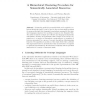Free Online Productivity Tools
i2Speak
i2Symbol
i2OCR
iTex2Img
iWeb2Print
iWeb2Shot
i2Type
iPdf2Split
iPdf2Merge
i2Bopomofo
i2Arabic
i2Style
i2Image
i2PDF
iLatex2Rtf
Sci2ools
AIIA
2007
Springer
2007
Springer
A Hierarchical Clustering Procedure for Semantically Annotated Resources
Abstract. A clustering method is presented which can be applied to relational knowledge bases. It can be used to discover interesting groupings of resources through their (semantic) annotations expressed in the standard languages employed for modeling concepts in the Semantic Web. The method exploits a simple (yet effective and language-independent) semi-distance measure for individuals, that is based on the resource semantics w.r.t. a number of dimensions corresponding to a committee of features represented by a group of concept descriptions (discriminating features). The algorithm is an fusion of the classic Bisecting k-Means with approaches based on medoids since they are intended to be applied to relational representations. We discuss its complexity and the potential applications to a variety of important tasks. 1 Learning Methods for Concept Languages In the inherently distributed applications related to the Semantic Web (henceforth SW) there is an extreme need of automatizing th...
| Added | 07 Jun 2010 |
| Updated | 07 Jun 2010 |
| Type | Conference |
| Year | 2007 |
| Where | AIIA |
| Authors | Nicola Fanizzi, Claudia d'Amato, Floriana Esposito |
Comments (0)

